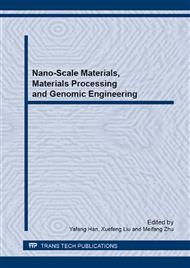p.12
p.18
p.28
p.32
p.36
p.44
p.48
p.54
p.59
Preparation of 1D or 3D Nano ZnO Crystals in High-Viscosity Solvent
Abstract:
1D or 3D nanoZnO crystals were prepared in diethylene glycol (DEG) via solvothermal process without surfactants at 160oC. Zinc acetate dihydrate was elected as zinc source, while water, sodium hydroxide, or ammonia solution was respectively as assistant agents. The morphologies of the products were characterized by field emission scanning electron microscopy (FESEM), high-resolution transmission electron microscopy (HRTEM), and selected area electron diffraction (SAED). With a certain content of water or sodium hydroxide, 1D ZnO nanorods were gained, having diameters of 20-90 nm and lengths of 0.04-1.8μm. With a certain content of ammonia solution, 3D shiitake-like ZnO hierarchical structures were gained. The pileus of shiitake structure composes of nanorods with diameters of 35-40 nm, while the stipe composes of one hexagonal rod with diameters of 250-350nm, or many hexagonal rods with diameters of 100-200nm. The morphology and size could be regulated by changing the amount of water, NaOH, or ammonia solution. Solvothermal process in high-viscosity solvent may provide a facile method for preparing nanomaterials.
Info:
Periodical:
Pages:
36-43
Citation:
Online since:
April 2014
Authors:
Keywords:
Price:
Сopyright:
© 2014 Trans Tech Publications Ltd. All Rights Reserved
Share:
Citation:


